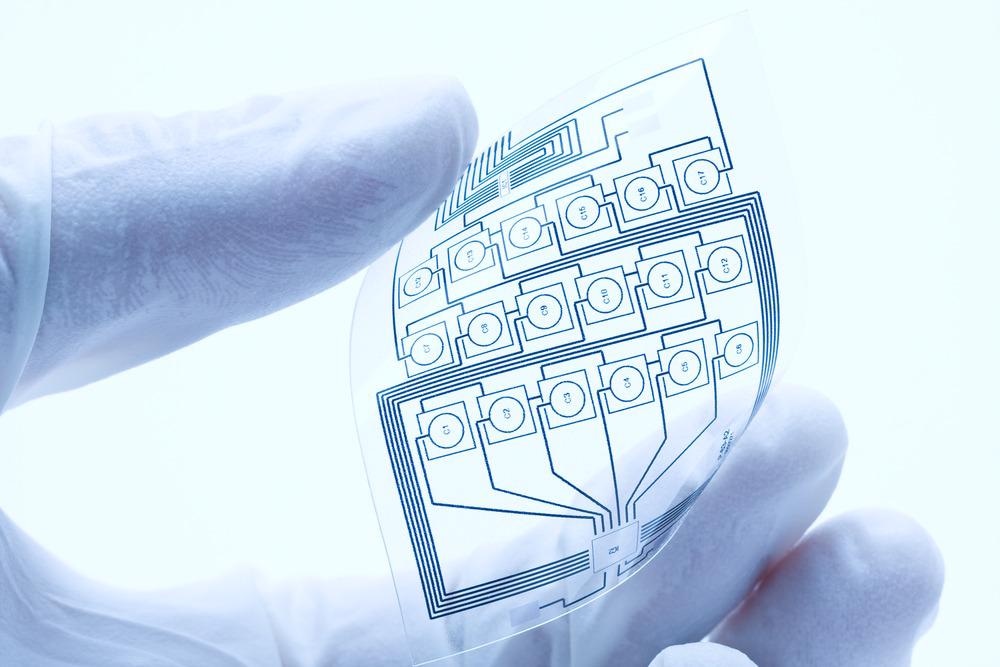Consider all of the electronics devices you own right now. Every time you realize you forgot to charge your device, imagine if you could charge the same device while walking or jogging.

Image Credit: Shawn Hempel/Shutterstock.com
Imagine a smartphone or laptop that is as light as a feather and completely foldable. Although this may seem far-fetched, innovations in flexible electronics are bringing these possibilities to life.
The idea of flexible electronics has been around for a long time. However, the rising demand for lightweight and wearable devices has created huge strides in developing materials that are flexible or can simply be fabricated on a flexible substrate.
Traditional Si-based electronics and inorganic materials are commonly rigid and brittle, not suitable for flexible electronics. Metal oxides, such as indium tin oxide and fluorine-doped tin oxide, are widely used in optoelectronic applications because of their transparency and conductivity, although their brittle nature limits their flexibility.
Polymer Nanomaterials: New Class of Materials
An emerging new class of materials called polymer nanomaterials are mechanically flexible, conductive, biocompatible, and capable of self-healing. Polymer nanoparticles are categorized based on their electrical conductivity; this feature directly dictates their application directions. Conductive polymers include polyacetylene (PA), polyaniline (PANi), polypyrrole (PPy), polythiophene (PTh), and poly(3,4-ethylenedioxythiophene):polystyrenesulfonate (PEDOT:PSS) and dielectric polymer includes poly vinyl alcohol (PVA), polydimethylsiloxae (PDMS), polylactide (PLA), polycaprolactone (PCL).
Recent Developments
Because of the growing demand for health monitors, there is a considerable need for lightweight and wearable bioelectronics devices to minimize further health issues. One of the most prominent examples is the pacemaker.
A cardiac pacemaker is no less than a miracle for people suffering from cardiovascular diseases. However, ordinary battery-powered pacemakers have a limited lifespan, and extra surgery is still required to replace the device, posing a significant risk to patients. To overcome this issue, Prof. Sara Azimi and a team of scientists from the University of Kashan, Iran, developed a poly(vinylidenefluoride) and reduced graphene oxide-based self-powered flexible piezoelectric nanogenerator (PNG).
They implemented the PNG on a model animal and reported that it could successfully harvest
0.487 μJ from every heartbeat. This energy is conveniently larger than the pacing threshold energy for the human heart. Moreover, their PNG has shown excellent biocompatibility and flexibility
Furthermore, Prof. Roger and the team of researchers from Northwest University have reported a biocompatible and flexible device on the surface of thin polydimethylsiloxane (PDMS) foil. It has a water-soluble PVA substrate designed to measure the electrical signals produced by the heart, brain, and skeletal muscles. The device can be easily mounted on the skin and peeled off.
Transparent conductive films (TCF) are widely applied in modern optoelectronic applications such as solar cells, organic light-emitting diodes (OLEDs), and touch panels. However, Indium tin oxide (ITO) has limited TCF's further application in next-generation flexible devices.
To address this issue, Prof. Guo and his colleagues used a Mayer rod coating process to create silver nanowire (AgNW)-PEDOT:PSS composite for flexible transparent electrodes (FTEs). Because of its superior conductivity, stability, and optical transparency, PEDOT is commonly employed in solar devices.
The AgNW-PEDOT:PSS composite FTEs has shown excellent optoelectrical characteristics, with a sheet resistance of 12/sq and a transmittance of 96% at 550 nm. The newly created AgNW-PEDOT:PSS composite FTE could be a promising replacement for fragile and costly ITO in flexible touch panels.
The human body is an abundant source of energy. It is possible to harvest energy from basic human activities, such as jogging, walking, running, and performing daily tasks. One of such wearable tabs was developed by a team of researchers from the University of Buffalo and the Chinese Academy of Science.
They developed a PDMS-based triboelectric nanogenerator (TENG) of 1.5cm long and 1cm wide that can generate electricity from simple body movements, such as the bending of a finger. TENG promises a maximum voltage of 124V and a maximum current of 10A, paving the way for creating smaller devices for future wearable and self-powered electronics and optoelectronics applications.
Challenges
Although polymer-based flexible electronics is a fast-growing technology, its biocompatibility and biodegradability are some of the biggest challenges. For example, PDMS-based flexible electronics are showing promising solutions in optoelectronics, bioelectronics, and energy harvesting. However, the biodegradability of PDMS is a major issue that significantly limits its applications. Nonetheless, there is always space for improvement by discovering better and more appropriate solutions.
The Future of Flexible Electronics
With growing development and new findings, wearable and flexible electronics will soon be integrated into essential parts of everyday life.
The medical world will witness many innovative devices such as electronics skin, flex circuits in contact lenses, and health monitors in the near future. Consumers may see the printable solar technology on clothes which could recharge phone and laptop batteries. The era of flexible electronics is real, and it is here to stay.
Continue reading: The Flexible Electronics Made from Graphene.
References and Further Reading
Azimi, S. et al. (2021) Self-powered cardiac pacemaker by piezoelectric polymer nanogenerator implant. Nano Energy, 83, [105781]. Available at: https://www.sciencedirect.com/science/article/pii/S2211285521000392?via%3Dihub
Kim, D. et al. (2011) Epidermal Electronics. Science 333, 843. Available at: https://www.science.org/doi/10.1126/science.1206157
H Yang et al. (2019) Facile fabrication of large-scale silver nanowire-PEDOT:PSS composite flexible transparent electrodes for flexible touch panels Mater. Res. Express 6 086315 Available at: https://www.science.org/doi/10.1126/science.1206157
Chen, H. et al. (2018) Wearable and robust triboelectric nanogenerator based on crumpled gold films. Nano Energy, 46, 73–80. Available at: https://www.sciencedirect.com/science/article/pii/S2211285518300405?via%3Dihub
Disclaimer: The views expressed here are those of the author expressed in their private capacity and do not necessarily represent the views of AZoM.com Limited T/A AZoNetwork the owner and operator of this website. This disclaimer forms part of the Terms and conditions of use of this website.